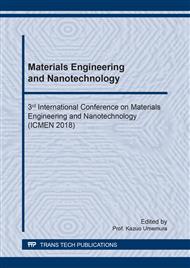p.126
p.136
p.142
p.151
p.159
p.164
p.171
p.178
p.187
Surface Modification of High Density Ceramic Powder for Increasing Suspension Capacity in Three-Dimensional Printing Application
Abstract:
Three-dimensional slurry printing is a promising tool for making ceramic object but it limits in high dense ceramic powder because of poor suspension capacity. This study uses zirconia powder with an average diameter of 2 μm because its density is 5.67 g/cm3. A treatment protocol is proposed to improve the suspension capacity of zirconia powder including the ball milling, surface modification and resin blending. Experimental results show that adding 1% of isostearyl titanate, a coupling agent, for surface modification can enhance the lipophilicity of zirconia powder. Mixing surface modification powder in resin with a weight ratio of 7:3 and carrying on ball milling with 100 RPM for 6 hours can obtain the diameter of powder less than 400 nm. As a result, the zirconia slurry can obtain good suspension capacity which is over 48 hours.
Info:
Periodical:
Pages:
159-163
Citation:
Online since:
October 2018
Authors:
Price:
Сopyright:
© 2018 Trans Tech Publications Ltd. All Rights Reserved
Share:
Citation:


